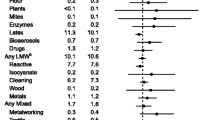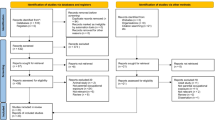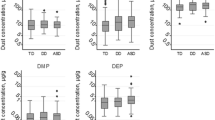Abstract
Both self-report and industrial hygienist (IH) assessed parental occupational information were used in this pilot study in which 174 families (93 children with ASD and 81 unaffected children) enrolled in the Childhood Autism Risks from Genetics and Environment study participated. IH results indicated exposures to lacquer, varnish, and xylene occurred more often in the parents of children with ASD compared to the parents of unaffected children. Parents of children with ASD were more likely to report exposures to asphalt and solvents compared to parents of unaffected children. This study was limited by the small sample size, but results suggest that workplace exposures to some chemicals may be important in the etiology of ASD and deserve further investigation.


Similar content being viewed by others
References
Allred, M., & Wilbur, S. (2002). Hazardous substance exposures and autism. In C. DeRosa, J. Holler, & M. Mehlman (Eds.), Advances in modern toxicology (pp. 453–473). Princeton, NJ: International Toxicology Books, Inc.
American Psychiatric Association. (2000). Diagnostic and statistical manual of mental disorders (4th ed. Text Revision). Washington, DC: American Psychiatric Association.
Benke, G., Sim, M., Fritschi, L., Aldred, G., Forbes, A., & Kauppinen, T. (2001). Comparison of occupational exposure using three different methods: Hygiene panel, job exposure matrix (JEM), and self reports. Applied Occupational and Environmental Hygiene, 16(1), 84–91.
Blaxill, M. F. (2004). What’s going on? The question of time trends in autism. Public Health Reports, 119, 536–551.
Bove, F. J., Fulcomer, M. C., Klotz, J. B., Esmart, J., Dufficy, E. M., & Savrin, J. E. (1995). Public drinking water contamination and birth outcomes. American Journal of Epidemiology, 141(9), 850–862.
Courchesne, E. (2004). Brain development in autism: Early overgrowth followed by premature arrest of growth. Mental Retardation and Developmental Disabilities Research Reviews, 10(2), 106–111.
Courchesne, E., Redcay, E., & Kennedy, D. P. (2004). The autistic brain: Birth through adulthood 5. Current Opinion in Neurology, 17(4), 489–496.
Croen, L. A., Grether, J. K., & Selvin, S. (2002). Descriptive epidemiology of autism in a California population: who is at risk? Journal of Autism and Developmental Disorders, 32(3), 217–224.
Dietert, R. R., & Dietert, J. M. (2008). Potential for early-life immune insult including developmental immunotoxicity in autism and autism spectrum disorders: Focus on critical windows of immune vulnerability. Journal of Toxicology and Environmental Health. Part B, Critical Reviews, 11(8), 660–680.
Doumouchtsis, K. K., Doumouchtsis, S. K., Doumouchtsis, E. K., & Perrea, D. N. (2009). The effect of lead intoxication on endocrine functions. Journal of Endocrinological Investigation, 32(2), 175–183.
Felicetti, T. (1981). Parents of autistic children: Some notes on a chemical connection. Milieu therapy, 1(1), 13–16.
Fritschi, L., Nadon, L., Benke, G., Lakhani, R., Latreille, B., Parent, M. E., et al. (2003). Validation of expert assessment of occupational exposures. American Journal of Industrial Medicine, 43(5), 519–522.
Frombonne, E. (2003). The prevalence of autism. The Journal of the American Medical Association, 289(1), 87–89.
Gillberg, C., & Coleman, M. (2000). The biology of the autistic syndromes (3rd ed.). London: Mac Keith Press.
Glasson, E. J., Bower, C., Petterson, B., de Klerk, N., Chaney, G., & Hallmayer, J. F. (2004). Perinatal factors and the development of autism: A population study. Archives of General Psychiatry, 61(6), 618–627.
Grandjean, P., & Landrigan, P. J. (2006). Developmental neurotoxicity of industrial chemicals. Lancet, 368(9553), 2167–2178.
Gurney, J. G., Fritz, M. S., Ness, K. K., Sievers, P., Newschaffer, C. J., & Shapiro, E. G. (2003). Analysis of prevalence trends of autism spectrum disorder in Minnesota. Archives of Pediatrics and Adolescent Medicine, 157(7), 622–627.
Hertz-Picciotto, I. (2009). Commentary: Diagnostic change and the increased prevalence of autism. International Journal of Epidemiology, 38, 1239–1241.
Hertz-Picciotto, I., Croen, L. A., Hansen, R., Jones, C. R., van de Water, J., & Pessah, I. N. (2006). The CHARGE study: An epidemiologic investigation of genetic and environmental factors contributing to autism. Environmental Health Perspectives, 114(7), 1119–1125.
Hertz-Picciotto, I., Park, H. Y., Dostal, M., Kocan, A., Trnovec, T., & Sram, R. (2008). Prenatal exposures to persistent and non-persistent organic compounds and effects on immune system development. Basic & Clinical Pharmacology & Toxicology, 102(2), 146–154.
Hooiveld, M., Haveman, W., Roskes, K., Bretveld, R., Burstyn, I., & Roeleveld, N. (2006). Adverse reproductive outcomes among male painters with occupational exposure to organic solvents. Occupational and Environmental Medicine, 63(8), 538–544.
Irgens, A., Kruger, K., Skorve, A. H., & Irgens, L. M. (1998). Reproductive outcome in offspring of parents occupationally exposed to lead in Norway. American Journal of Industrial Medicine, 34(5), 431–437.
Kalkbrenner, A. E., Daniels, J. L., Chen, J., Poole, C., Emch, M., & Morrissey, J. (2010). Perinatal exposure to hazardous air pollutants and autism spectrum disorders at age 8. Epidemiology, 21(5), 631–641.
Key, M. M., Henschel, A. F., Butler, J., Ligo, R. N., & Tabershaw, I. R. (Eds.). (1977). Occupational diseases. A guide to their recognition. Washington, DC: DHEW (NIOSH).
King, M., & Bearman, P. (2009). Diagnostic change and the increased prevalence of autism. International Journal of Epidemiology, 38, 1224–1234.
Klin, A., Jones, W., Schultz, R., Volkmar, F., & Cohen, D. (2002). Defining and quantifying the social phenotype in autism. American Journal of Psychiatry, 159(6), 895–908.
Larsson, H. J., Eaton, W. W., Madsen, K. M., Vestergaard, M., Olesen, A. V., Agerbo, E., et al. (2005). Risk factors for autism: Perinatal factors, parental psychiatric history, and socioeconomic status. American Journal of Epidemiology, 161(10), 916–925.
Laslo-Baker, D., Barrera, M., Knittel-Keren, D., Kozer, E., Wolpin, J., Khattak, S., et al. (2004). Child neurodevelopmental outcome and maternal occupational exposure to solvents. Archives of Pediatrics and Adolescent Medicine, 158(10), 956–961.
Logman, J. F., de Vries, L. E., Hemels, M. E., Khattak, S., & Einarson, T. R. (2005). Paternal organic solvent exposure and adverse pregnancy outcomes: A meta-analysis. American Journal of Industrial Medicine, 47(1), 37–44.
Lord, C., Risi, S., Lambrecht, L., Cook, E. H, Jr, Leventhal, B. L., DiLavore, P. C., et al. (2000). The autism diagnostic observation schedule-generic: A standard measure of social and communication deficits associated with the spectrum of autism. Journal of Autism and Developmental Disorders, 30(3), 205–223.
Lord, C., Rutter, M., & Le Couteur, A. (1994). Autism diagnostic interview-revised: A revised version of a diagnostic interview for caregivers of individuals with possible pervasive developmental disorders. Journal of Autism and Developmental Disorders, 24(5), 659–685.
McMartin, K. I., Chu, M., Kopecky, E., Einarson, T. R., & Koren, G. (1998). Pregnancy outcome following maternal organic solvent exposure: A meta-analysis of epidemiologic studies. American Journal of Industrial Medicine, 34(3), 288–292.
Moore, S. J., Turnpenny, P., Quinn, A., Glover, S., Lloyd, D. J., Montgomery, T., et al. (2000). A clinical study of 57 children with fetal anticonvulsant syndromes. Journal of Medical Genetics, 37(7), 489–497.
Mullen, E. M. (1995). Mullen’s scales of early learning. Circle Pines, MN: American Guidance Services Inc.
Newschaffer, C. J., Croen, L. A., Daniels, J., Giarelli, E., Grether, J. K., Levy, S. E., et al. (2007). The epidemiology of autism spectrum disorders. Annual Review of Public Health, 28, 235–258.
NIOSH. (2001) Registry of toxic effects of chemical substances (RTECS®). Cincinnati, OH: National Institute for Occupational Safety and Health. Available: http://www.cdc.gov/niosh/rtecs/RTECSaccess.html. Assessed 20 December 2010.
Pardo, C. A., & Eberhart, C. G. (2007). The neurobiology of autism. Brain Pathology, 17(4), 434–447.
Perera, F. P., Jedrychowski, W., Rauh, V., & Whyatt, R. M. (1999). Molecular epidemiologic research on the effects of environmental pollutants on the fetus. Environmental Health Perspectives, 107(Suppl 3), 451–460.
Pessah, I. N., Seegal, R. F., Lein, P. J., LaSalle, J., Yee, B. K., Van De Water, J., et al. (2008). Immunologic and neurodevelopmental susceptibilities of autism. Neurotoxicology, 29(3), 532–545.
Roberts, E. M., English, P. B., Grether, J. K., Windham, G. C., Somberg, L., & Wolff, C. (2007). Maternal residence near agricultural pesticide applications and autism spectrum disorders among children in the California Central Valley. Environmental Health Perspectives, 115(10), 1482–1489.
Roman, E., Doyle, P., Ansell, P., Bull, D., & Beral, V. (1996). Health of children born to medical radiographers. Occupational and Environmental Medicine, 53(2), 73–79.
Siemiatycki, J., Fritschi, L., Nadon, L., & Gerin, M. (1997). Reliability of an expert rating procedure for retrospective assessment of occupational exposures in community-based case-control studies. American Journal of Industrial Medicine, 31(3), 280–286.
Sparrow, S. S., Balla, D. A., & Cicchetti, D. V. (1984). Vineland adaptive behavior scales. Circle Pines, MN: American Guidance Services, Inc.
Stewart, P. A., & Stewart, W. F. (1994). Occupational case-control studies: II. Recommendations for exposure assessment. American Journal of Industrial Medicine, 26(3), 313–326.
Stromland, K., Nordin, V., Miller, M., Akerstrom, B., & Gillberg, C. (1994). Autism in thalidomide embryopathy: A population study. Developmental Medicine and Child Neurology, 36(4), 351–356.
Szatmari, P. (2003). The causes of autism spectrum disorders. British Medical Journal, 326(7382), 173–174.
Teschke, K., Olshan, A. F., Daniels, J. L., De Roos, A. J., Parks, C. G., Schulz, M., et al. (2002). Occupational exposure assessment in case-control studies: Opportunities for improvement. Occupational and Environmental Medicine, 59(9), 575–593. (discussion 594).
Volk, H. E., Hertz-Picciotto, I., Delwiche, L., Lurmann, F., & McConnell, R. (2011). Residential proximity to freeways and autism in the CHARGE study. Environmental Health Perspectives, 119(6), 873–877.
Wiedel, L., & Coleman, M. (1976). The autistic and control population of this study. Demographic, historical and attitudinal data. In M. Coleman (Ed.), The autistic syndromes (pp. 11–20). Amsterdam, Holland: North Holland Publishing.
Wiest, M. M., German, J. B., Harvey, D. J., Watkins, S. M., & Hertz-Picciotto, I. (2009). Plasma fatty acid profiles in autism: A case-control study. Prostaglandins Leukotrienes and Essential Fatty Acids, 80(4), 221–227.
Windham, G. C., Zhang, L., Gunier, R., Croen, L. A., & Grether, J. K. (2006). Autism spectrum disorders in relation to distribution of hazardous air pollutants in the San Francisco Bay area. Environmental Health Perspectives, 114(9), 1438–1444.
Xu, X., Cho, S. I., Sammel, M., You, L., Cui, S., Huang, Y., et al. (1998). Association of petrochemical exposure with spontaneous abortion. Occupational and Environmental Medicine, 55(1), 31–36.
Acknowledgments
The authors would like to thank the families who participated in the CHARGE research project. It is because of their time and commitment that we were able to conduct this research. The authors would also like to thank Lora Delwiche at the University of California, Davis for her help with data management during this project. Grant sponsor: National Institutes of Health, Grant numbers: 1 P01 ES11269, 1 R01 ES015359, Grant sponsor: U.S. Environmental Protection Agency through the Science to Achieve Results (STAR) program, Grant numbers: R829388, R833292.
Author information
Authors and Affiliations
Corresponding author
Additional information
The findings and conclusions in this report are those of the author(s) and do not necessarily represent the views of the National Institute for Occupational Safety and Health.
Rights and permissions
About this article
Cite this article
McCanlies, E.C., Fekedulegn, D., Mnatsakanova, A. et al. Parental Occupational Exposures and Autism Spectrum Disorder. J Autism Dev Disord 42, 2323–2334 (2012). https://doi.org/10.1007/s10803-012-1468-1
Published:
Issue Date:
DOI: https://doi.org/10.1007/s10803-012-1468-1




